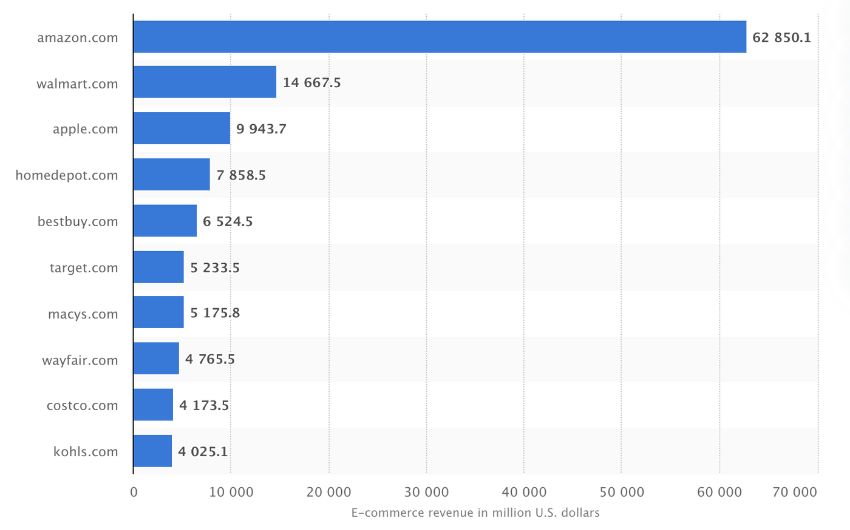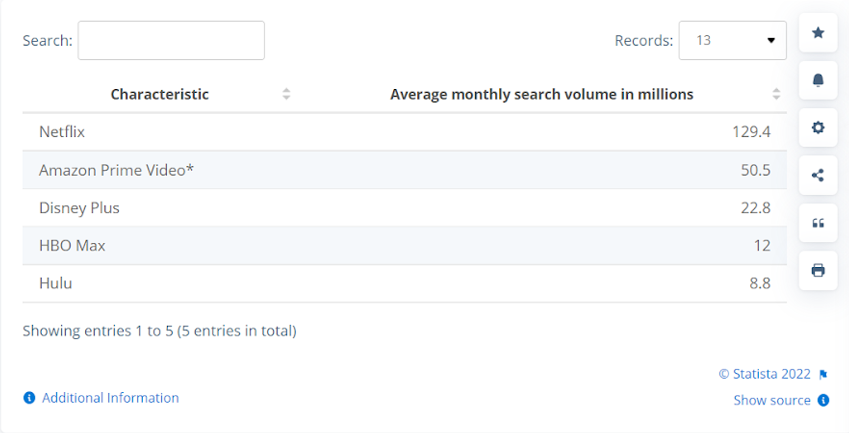As the largest ecommerce retailer by online revenue, Amazon.com is an undisputed leader in online retail space. It has a huge variety of product selections and runs multiple online stores all over the world. Launched by Jeff Bezos in 1994, just outside of Seattle, Washington, it is now available in over 190 countries, with more than 500 million products.
In addition to being an online retailer, Amazon also operates an online marketplace for third-party sellers where they can sell their goods, and Amazon gets a commission on each sale. Furthermore, it provides services like Amazon Prime, Amazon Web Services, and Alexa.

With these services, Amazon has become one of the most powerful companies in the world, and it continues to grow at an unprecedented rate. In a time when there is so much turmoil in the market and with so many stores starting to close, Amazon continues to dominate the retail industry.
Amazon’s Dominance in Ecommerce and What it Means For You
In 2020, Amazon topped the list of global publicly-traded internet companies in terms of company revenue. Its annual revenue of nearly $386 billion surpassed that of Google and Alibaba, with revenues of $181.7 billion and $109.5 billion, respectively.

As a matter of fact, all online stores have to accept that ultimately, they are competing with Amazon, irrespective of their industry or the size of their business. Because Amazon practically sells everything on its platform.
Moreover, Amazon’s market share is expected to comprise 50% of the entire e-commerce retail market’s gross merchandise volume.
Amazon’s business model
Let’s start with the bigger picture to look into how the biggest online retailer has found its way to the summit. While Amazon started out as an online retailer of books, it has grown over the decades to become the largest e-commerce company by revenue.
It is known that Amazon has some of its best products on sale via third parties that provide a high-quality product selection.
A large portion of these have private labels, and the rest sell wholesale, retail, online arbitrage, dropshipping and handmade products. This business model enables Amazon to spend considerable money in production and storage.
In a sense, they act as intermediaries between sellers and buyers and are able to connect the two companies rather than acting as separate online stores.
While there is no question on Amazon’s leading role in the retail space, there are other players with noteworthy achievements, showing decent growth in popularity, and are worth a mention.
For instance, in the upcoming field of streaming services, Netflix is a competitor to Amazon Prime Video. Amazon’s Alexa has a competitor in Google Home products. Other than the mentioned examples, Amazon also sees competition in the form of popular B2B and B2C ecommerce companies.
Top 10 Amazon’s Biggest Competitors

If you own one or more online stores, you can get a clue from these below-mentioned competitors and how they make it work successfully in the face of stiff competition.
Amazon’s list of competitors consists of a surprising ensemble of ecommerce stores from niche websites to retail giants. Following are ten of the top players competing with Amazon.
1. Walmart
Also a retail giant, Walmart has been in operation since 1962 and caters to more than 200 million customers each week at more than 11,000 stores in 27 countries. Walmart’s success can be attributed to its competitive prices and its ability to offer discounts on virtually every item. It can be said that the company has mastered the art of retailing.
Walmart has been making a lot of changes in the past few years to compete with Amazon. It has been investing in eCommerce business by doubling down on its grocery delivery service and adding more products to its website.
Walmart has also been trying to get more people into their stores by offering discounts and free shipping on orders over $35 dollars. Undeniably, Walmart is one of the top Amazon competitors, and it is growing at a rapid pace. Behind Amazon, Walmart is the second most popular among online stores in the United States in terms of ecommerce revenue.

2. Target
Target is another big retail store and has been around since the 1960s. It is the number two store in the U.S. behind Walmart and has more than 1800 stores and nearly 350,000 employees.
Target identifies itself as an ‘all-round merchandiser’ and claims that 75% of Americans live within a five-mile distance of it. Though competing head-on with Amazon is a longshot for Target, its strength lies in customer loyalty.
The company has developed its brand as a place where people like to shop. Furthermore, it has been making efforts to build on aspects such as same-day delivery and curbside pickup.
3. Costco
Costco started as a membership warehouse club store back in the 70s. It was founded in San Diego, California, and has now expanded to more than 700 locations worldwide.
It offers its members wholesale prices on products in bulk. They are best known for their low prices on food and other household goods, but they also offer clothing, electronics, furniture, jewelry, and much more.
The company’s success is attributed to their low prices and the fact that they carry only those items which will sell at a high volume. Costco has been able to maintain its competitive edge by constantly looking for ways to save money while still maintaining quality.
With the latest developments in the retail industry, Cosco has undertaken expansion in the global markets. It has introduced innovative practices that generated a consumer following, denoted as ‘The Costco Craze.’
4. Facebook Marketplace and Facebook Shops
With Facebook Marketplace, people connect with others in the community to buy and sell items. There can be items on sale in the vicinity or any part of the world.
People post about items to sell, which buyers can get for a set price, or get offers from buyers. People interested in discarding old items or getting some new ones can often be found browsing and buying at Facebook Marketplace.
With its popularity growing as of the beginning of 2021, it has already surpassed 1 billion users globally.
5. Subscription services
Netflix is a leading streaming service and gives Amazon Prime tough competition. As of March last year, the Netflix paying subscriber count was 207.6 million, as noted in a report.
In 2021, the streaming service that emerged with the highest average monthly search volume worldwide was Netflix, and the average monthly searches amounted to 129.4. At the second spot, Amazon Prime Video recorded 50.5 million average monthly search volume.

6. Alibaba / Aliexpress
Alibaba is a China-based online retailer. This international giant specializes in wholesale selling online, which is a different business model from Amazon. It also differs from Amazon in another aspect — unlike Amazon being the umbrella brand for its different services, Alibaba operates separate businesses like Alibaba, Taobao, and Tmall.
With Alibaba covering the B2B aspect, the other two businesses cover the B2C segment and multinational brands, respectively. As of June 2019, Alibaba had 755 million worldwide users.
7. JD
JD offers its customers the option to buy a wide variety of products at affordable prices. It is a Chinese ecommerce company and is known as 360buy. The Fortune 500 firm is the direct competitor to Alibaba’s Tmall.
In 2021, JD reported an over 20% rise in customer accounts as compared to the previous year.
8. Otto
The European web retail company has been known throughout the years for introducing innovative solutions in a bid to remain current with the times. Otto’s top categories include fashion, electronic products (including iPhone and Windows computers), home goods, and sports.
The platform’s popularity has mainly been attributed to its simple interfaces. It makes online shopping easier. Otto made revenue of as much as $3.8 billion in online sales in 2019.
9. Newegg
Newegg sells electronics online, including smartphones, tablets, smartphones, computers, and so on. It is a global leader, offering its customers a wide range of electronic items on an online-only platform.
Considering the popularity of electronic products on Amazon as its highest-selling category, Newegg’s success has the potential to challenge the retail giant’s leading position in the sector. Amazon.com is leading the consumer electronics online marketplace in the U.S. Its ecommerce net sales in 2020 were $38,073 million.
10. eBay
All of us know about eBay. The site is a leading online marketplace leader in online shopping. With time, eBay has evolved as a platform for buyers of new products and a platform for selling used products to others. Today eBay has used B2C online sales alongside C2C online sales. The site visits are second only to Amazon. eBay has been attracting great visitor traffic.
The eBay and amazon rivalry has been going on for a long time. They are both big players among online marketplaces, though they have different strategies to maintain their dominance. eBay is a marketplace where people can buy and sell products from all over the world, while Amazon is a retailer that sells products only through its own online stores.
Amazon uses its market dominance and vast resources to lower prices for customers, while eBay attempts to maintain its perceived value by providing buyers and sellers with a platform that is seen as trustworthy.
What is the Best Way to Compete with Amazon?

There are many ways to compete with Amazon, but the most successful strategies involve focusing on what you do best. This means either going after an entirely different market or making sure your products are better than Amazon’s in some way.
Offer something different
Amazon offers everything from clothes to food and more, so it’s hard to compete with them on the same field. Instead, find something they don’t offer and offer it as an alternative. For example, if you’re selling clothes and they sell clothes too, try to sell clothes for plus-size people or children.
Building a unique brand identity differentiates you from your competition and gives your customers a reason to remember and be drawn to you. It’s important to do your research before you start building your brand and make sure that you know what makes a successful company so you can avoid their mistakes.
Prioritize customer service
This is an important point that is overlooked sometimes. If you’re willing to go above and beyond for your customers, then it is a good indicator that you have the drive needed to succeed.
There are many different ways to compete with Amazon, but one of the most important things is customer service. While Amazon might have started as a place for people to buy books, it has evolved into a place for customers to get anything they need. But what happens when customers encounter problems with products?
Some companies have found success by focusing on customer service as their competitive advantage. They focus on making sure that their customers are satisfied with their experience, even if they have had problems with products that they bought from them.
Moreover, the best way for companies to compete with Amazon is by offering better customer service, lower prices, and more variety in their products.
[Also read: Customer Journey: A Digital Marketing Journey of a US Ecommerce Giant]
Ecommerce SEO
Ecommerce SEO is something that needs to be a priority for all B2B ecommerce companies. This is because the majority of customers are looking for products on Amazon before they decide to buy them elsewhere.
All B2B ecommerce stores need to make sure that their site ranks well on Google so that they can be found by potential customers. Utilize tools that allow for the assessment of the competition in the online marketplace so that you know how to optimize your eCommerce website for this platform. B2B ecommerce entrepreneurs should use these tools and make sure to rank their site.
Amazon is a huge player in the e-commerce industry. They have a vast array of products, low prices, and convenient delivery options. With so much competition, it can be hard to compete with Amazon and win online. However, there are some ways that you can beat Amazon in its own game.
1) Offer a better selection of products
2) Have more competitive prices
3) Deliver faster than Amazon
4) Offer personalized customer service
5) Provide quality assurance with your products
6) Offer a wider variety of shipping options
It is necessary to understand your niche and create content that provides a unique value proposition to your customers.
Related Articles
-
Your Shopify Analytics Roadmap to eCommerce Business Growth
Embarking on a successful e-commerce journey requires a well-defined Shopify Analytics Roadmap. In this guide, we unravel the intricacies of leveraging Shopify analytics for sustainable business growth. Uncover actionable insights,
-
Go Composable with Adobe Commerce
Many stores now choose composable commerce to give people a better customer experience. This method works well in many situations, but stores must think carefully about the trade-offs. This article
-
10 Ecommerce Trends to Boost Business Growth in 2020
Adapting to the dynamic needs of consumers is something that every eCommerce business owner does every day. It’s 2020 and if you own such a business, then get prepared! This



